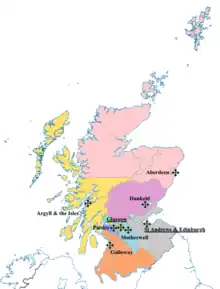The Bishop of Caithness was the ecclesiastical head of the Diocese of Caithness, one of Scotland's 13 medieval bishoprics. The first referenced bishop of Caithness was Aindréas, a Gael who appears in sources between 1146 and 1151 as bishop. Aindréas spent much if not all of his career outside his see.
Other bishops before Aindréas are possible, but none is documented. King David I of Scotland, is credited with founding many bishoprics, and it is possible that Caithness was one of them. Little documented history exists before the reign of King David.
The earliest bishops resided at Halkirk, with a castle at Scrabster. Bishop Gilbert de Moravia moved the episcopal seat to Dornoch in what is now Sutherland (then regarded as part of Caithness), and the bishopric remained at Dornoch Cathedral for the remainder of its existence. The Bishopric of Caithness' links with Rome ceased to exist after the Scottish Reformation, but the bishopric continued, saving temporary abolition between 1638 and 1661, under the episcopal Church of Scotland until the Revolution of 1688 led to the permanent abolition of episcopacy in the established church in Scotland (now Presbyterian in government) in 1689.
List of parishes
List of Bishops
| Tenure "x" |
Incumbent | Notes |
|---|---|---|
| - | See Notes | Some lists give Angerius Brito; this is in fact Bishop Angerius of Catania in Sicily. Catania and Caithness were often written identically. See G. W. S. Barrow, "Angerius Brito, Cathensis Episcopus", in Traditio, xxvi, (1970), p. 351. |
| 1147 x 1151-1184 | Aindréas of Caithness | First known bishop of Caithness; famously, Aindréas is named as a source by the writer of de Situ Albanie. |
| 1184 x 1199-1202 | John of Caithness | |
| 1213-1222 | Adam of Melrose | Formerly Abbot of Melrose; was burned to death in his kitchen, at Halkirk, by the husbandmen of Caithness, in a tithe revolt. |
| 1222 x 1223-1245 | Gilbert de Moravia | Moved the seat of the diocese to Dornoch |
| 1246 x 1247-1255 | William | |
| 1263-1270 | Walter de Baltrodin | |
| 1272 x 1273 | Nicholas | Nicholas had been abbot of Scone. Pope Gregory X refused to confirm his election because of his "intolerable lack of learning". |
| 1274-1275 x 1278 | Archibald Heroch | |
| 1278-1279 | Richard | Richard had been Dean of Caithness. Richard was old and infirm by the time of his election; Pope Nicholas III persuaded Richard to resign his election rights. |
| 1279-1282 | Hervey de Dundee | Hervey was elected to the see after the resignation of Bishop Richard. Hervey died on his way for confirmation at the Papal court. |
| 1282-1291 | Alan de St Edmund | |
| 1291 x 1296 | John | |
| 1296 | Adam de Darlington | |
| 1296-1297 x 1304 | Andrew de Buchan | |
| 1304-1321 x 1327 | Fearchar Belegaumbe | |
| 1328-1329 x 1341 | David | |
| 1341-1342 | Alan de Moravia | |
| 1342-1365 x 1369 | Thomas de Fingask | |
| 1369-1379 x 1380 | Maol Choluim de Drumbreck | Drumbreck (now Dumbreck) is in Aberdeenshire, near Pitmedden[2] |
| 1381-1412 | Alexander Man | |
| 1414-1422 | Alexander Vaus | |
| 1422-1426 | John de Crannach | |
| 1427-1445 x 1446 | Robert de Strathbrock | |
| 1446-1447 x 1448 | John Innes | |
| 1448-1477 | William Mudy | |
| 1478-1484 | Prosper Camogli de' Medici | Also known as Prosper Camulio de Janua. |
| 1484 | John Sinclair | |
| 1501-1517 | Andrew Stewart (elder) | |
| 1517-1540 x 1541 | Andrew Stewart (younger) | |
| 1544-1548 | Alexander Gordon | Provided by Crown to replace Stewart; resigned claim in 1548. |
| 1542-1586 | Robert Stewart | Second son of John Stewart, 3rd Earl of Lennox, and brother of Matthew Stewart, 4th Earl of Lennox. He spent many years as "bishop postulate" in England. He became a reformer, although he retained the title of bishop until his death in 1586. |
| 1586-1587 | Robert Pont | |
| 1600-1604 | George Gledstanes | Translated to Archbishopric of St Andrews. |
| 1604-1616 | Alexander Forbes | |
| 1616-1638 | John Abernethy | |
| 1638 | Robert Hamilton | Episcopacy abolished in Scotland until Restoration of 1661. |
| 1662-1680 | Patrick Forbes | |
| 1680-1688/9 | Andrew Wood | Episcopacy permanently abolished in the Church of Scotland. He died aged 76 years old, in 1695. |
List of bishopric seats
- Bishop's Palace, Halwick
- Bishop's Palace, Scrabster
- Bishop's Palace, Dornoch
References
- ↑ "Parish List – Scottish Place-Name Society". Retrieved 1 February 2021.
- ↑ Black, George Fraser (2015). The surnames of Scotland : their origin, meaning, and history. [Vermont]: Birlinn, Ltd. p. 654. ISBN 9781626540590.
- Broun, Dauvit, "The Seven Kingdoms in De Situ Albanie: A Record of Pictish political geography or imaginary Map of ancient Alba", in E.J. Cowan & R. Andrew McDonald (eds.), Alba: Celtic Scotland in the Medieval Era, (Edinburgh, 2000, rev. 2005).
- Crawford, Barbara, "The Earldom of Caithness and the Kingdom of Scotland, 1150-1266" in Keith Stringer (ed.), Essays on the Nobility of Medieval Scotland, (Edinburgh, 1985), pp. 25-43
- Dowden, John, The Bishops of Scotland, ed. J. Maitland Thomson, (Glasgow, 1912)
- Jackson, Kenneth H. (ed), The Gaelic Notes in the Book of Deer, (Cambridge, 1972)
- Keith, Robert, An Historical Catalogue of the Scottish Bishops: Down to the Year 1688, (London, 1924)
- Lawrie, Sir Archibald, Early Scottish Charters Prior to A.D. 1153, (Glasgow, 1905)
- Watt, D.E.R., Fasti Ecclesiae Scoticanae Medii Aevi ad annum 1638, 2nd Draft, (St Andrews, 1969)
.png.webp)
